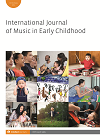
Full text loading...

This article provides a broad overview of the theoretical approaches underpinning our understanding of early musical development, and considers how this sets the foundation for later development across the lifespan. Through a review of research evidence and theory, I argue for the importance of interaction in thinking about musical development: movement is at the heart of theories of development; interaction and synchrony form the foundation for music learning; and motivation, agency and identity shape patterns of early engagement with music. The importance of setting these activities in context is also emphasized: for parents, teachers and researchers to fully understand young children’s musical experiences, it is vital to consider the cultural contexts and histories of the musical materials, the listener and the situation, as well as how these interact.

Article metrics loading...

Full text loading...
References


Data & Media loading...

Publication Date:
https://doi.org/10.1386/ijmec_00010_1 Published content will be available immediately after check-out or when it is released in case of a pre-order. Please make sure to be logged in to see all available purchase options.